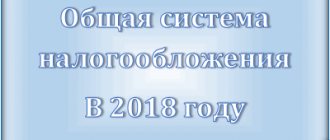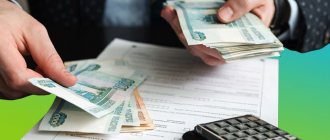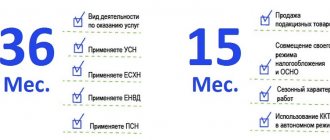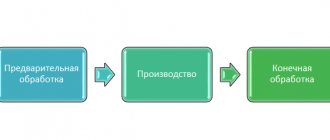Mandatory tax payments
Income tax according to general rules is 20% for organizations and 13% on income for entrepreneurs. The new beneficiaries include IT enterprises; they were allowed to pay no more than 3%. Moreover, as much as 0% goes to the regional budget.
A complete list of beneficiaries can be found in Art. 284–284.6 Tax Code of the Russian Federation.
The remaining organizations send 17% to the federal budget and 3% to the regional budget. Entrepreneurs finance 13% of the budget at their place of registration.
The amount of value added tax depends on the type of activity and the product sold, it varies from 0 to 20%.
Property tax for organizations reaches 2.2%, for entrepreneurs up to 2%.
How to calculate the 6% simplified tax system: determine the amount of advance payments
AvPr = Nb × 6%,
Nb is the tax base, which represents the taxpayer’s income on an accrual basis from the beginning of the year.
AvPu = AvPr – Nvych – Ts – AvPpred,
AvPr is an advance payment corresponding to the tax base calculated from the beginning of the year to the end of the reporting period;
Nvych - a tax deduction equal to the amount of insurance premiums paid to the funds, temporary disability benefits paid to employees, transferred payments for voluntary insurance in favor of employees;
Тс - the amount of the trade fee paid to the budget (if the type of activity carried out by the taxpayer falls under this fee);
AvPpred. - the amount of advances paid based on the results of previous reporting periods (such deduction is provided for in paragraphs 3, 5 of Article 346.21 of the Tax Code of the Russian Federation).
The amount of tax deduction for individual entrepreneurs who work for themselves and do not have employees is not limited (paragraph 6, clause 3.1, article 346.21 of the Tax Code of the Russian Federation), i.e. this deduction for individual entrepreneurs can reduce the amount of accrued tax to 0. An entrepreneur who there are hired employees, they have the right to apply a tax deduction only in the amount of 50% of the tax amount calculated from the tax base (paragraph 5, clause 3.1, article 346.21 of the Tax Code of the Russian Federation).
This limitation applies only to insurance premiums, temporary disability benefits and payments for voluntary insurance. It does not apply to the trade fee (clause 8 of Article 346.21 of the Tax Code of the Russian Federation, letter of the Ministry of Finance of Russia dated October 7, 2015 No. 03-11-03/2/57373). And even when the maximum possible deduction amount is reached due to the amount of contributions, benefits and payments for voluntary insurance, the accrued tax can be further reduced by the amount of the trade tax.
In this case, the taxpayer must be registered as a payer of such a fee.
Read about the specifics of calculating the trading fee in this section.
At the end of the year, the last calculation of the simplified tax system for the tax period is carried out at 6%, subject to additional payment to the budget. Please keep in mind that there may be an overpayment. This amount will either be offset against future payments or returned to the taxpayer's account.
N = Ng – Nvych – Ts – AvP,
We suggest you read: Is it possible to get a deduction if the receipts have not been saved?
Ng - the amount of tax, which is the result of multiplying the tax base calculated for the entire year by 6%;
AvP - the amount of advance payments that are calculated during the reporting periods of the reporting year.
For more information about what a single tax is, which is paid under the simplified tax system, read the article “What taxes does the simplified tax system replace?”
Advance payments are made based on the results of each reporting period:
- for the 1st quarter - no later than 04/27/2020 (April 25 - Saturday);
- for the 2nd quarter - no later than July 27, 2020 (July 25 - Saturday);
- for the 3rd quarter - no later than October 26, 2020 (October 25 - Sunday).
At the end of the year, tax is paid:
- legal entities - no later than March 31;
- individual entrepreneurs - no later than April 30.
Let us repeat, in 2021 these are working days, so there will be no postponements of the payment deadline.
A sample payment form for payment of the simplified tax system “income” can be viewed here.
If payers fail to pay taxes and advance payments on time, penalties will be assessed.
Our penalty calculator will help you calculate penalties for legal entities.
Combination
Organizations would be glad if it was possible to combine it with any special regime, but such a possibility is not provided for in the Tax Code.
Entrepreneurs can cross OSN with PSN, i.e. buy a patent for a different type of activity from the traditional one.
And if an LLC operates under the general taxation system, can its separate division apply the simplified “income minus expenses”?
It is impossible if the parent organization is on the common taxation system.
Goals of Calculus
The characteristics of the tax base can be very different: physical, cost, volume of cash turnover, and others. And to calculate the tax base in each specific case, the rules prescribed in tax legislation, in particular in the Tax Code, are used.
The main purpose of calculating the tax base is the correct application of the tax rate for the period, as well as the payment by the taxpayer of the tax established for him.
If errors are made when determining the tax base, two options are possible:
- recalculation for the period in which this error was made;
- recalculation for the period in which this error was discovered.
If the tax base is calculated incorrectly, the tax authority cannot correctly apply either the tax rate or collect the tax from the payer. That is why Article 17 of the Tax Code establishes that a tax is considered paid only when several criteria are correctly defined. Namely:
- bid;
- period;
- base;
- payer;
- calculation and payment procedure.
If an error is made in at least one of the criteria, the tax is considered unpaid, not paid in full, or paid erroneously, which results in a recalculation by the tax authorities.
Accounting
This is the most interesting thing. The annual profit value depends on the confirmation of expenses and explanation of income. When losses are incurred, income tax is not charged.
Income can take either cash or in-kind form. Accountants must separately account for sales and non-sales income. In Art. 251 there is a closed list of income that cannot affect income tax.
The financial result at the moment will depend on what strategy the organization has chosen in its accounting policy.
The taxpayer has the right to adjust the method of recognition of income and expenses.
The accrual method allows income to be calculated on the day of transfer of ownership when selling property (except for real estate) or the date of transfer of the results of work performed, services provided, as well as property rights.
The cash method considers income on the day the money or other property is received.
The rules for recognizing non-operating income are established in clause 4 of Art. 271 Tax Code of the Russian Federation.
With expenses it is even more difficult and strict. They must fulfill three conditions at once:
- be economically justified;
- related to the income received;
- documented.
Despite the fact that the code does not have a clear list of supporting documents, for any violation of the registration of such a primary document, the tax inspector will refuse to reduce income.
You need to clearly understand what you are spending your money on:
- expenses from art. do not reduce profit. 270 code;
- non-operating expenses can be written off, but in a certain amount (Article 265 of the Tax Code of the Russian Federation);
- You use direct and indirect costs directly for the production of goods, works and services. Direct expenses are calculated simultaneously with the sale of goods, and indirect expenses are written off at a time in the current period.
Results
The tax base for transport tax for vehicles with an engine is the engine power expressed in horsepower. For non-propelled water vehicles, the tax is calculated on the basis of gross tonnage in registered tons, and for aircraft - on the basis of the static thrust force of the jet engine, expressed in kilograms. For other watercraft and aircraft, the tax base is taken as a unit of vehicle.
Calculation of tax on profits at the end of the year is carried out by multiplying the tax base by the rate. The indicators that form the base are taken from tax accounting data and cover the entire tax period, equal to a year. The amount of tax in this calculation is calculated for 12 months. To obtain the amount that will be paid (or returned from the budget) based on the results of the annual calculation, it should be reduced by the amount of advance payments accrued for the year.
The calculation of the simplified tax system for the object “income” is done quarterly: the amounts of advances are calculated 3 times, and at the end of the year the final tax amount is determined. The calculation base is the income received for the period (each time determined on an accrual basis), which is multiplied by the rate (usually 6%, but in the regions it can be reduced).
The amount of tax obtained from this calculation can be reduced by insurance premiums, disability benefits and voluntary insurance payments paid for the corresponding period. For employers, the amount of such a deduction cannot exceed 50%, and for individual entrepreneurs who do not have employees, it is possible to reduce accruals by 100%. The amount that supplements the deduction (in excess of 50%) will be the amount of the trading fee paid during the period.
In all periods except the 1st quarter, the amount calculated in this way is additionally reduced by the amount of advances accrued in previous reporting periods.
How to reduce income tax under OSNO?
The tax depends on the tax base, it is affected by the income received and the expenses incurred. There is no rescue pill, but there are several legal ways:
- find unaccounted expenses, for example, for employee training, uniforms, marketing services, depreciation of fixed assets, payment of government duties, etc.;
- review accounting policies;
- purchase fixed assets on lease;
- detect losses from previous years;
- take advantage of income tax benefits.
How to calculate the simplified tax system “income”
To calculate the simplified tax system, the taxpayer who has selected the “income” object should perform the following steps:
- calculate the tax base;
- determine the amount of the advance payment;
- determine the final amount of tax to be paid.
The rules and formulas that apply at each stage do not allow for ambiguity. The peculiarities may only affect the rate of this type of tax, since regions are given the right to set rates other than 6%. True, only in the direction of decrease. The reduced rate cannot be lower than 1% (with the exception of the 0% rate for individual entrepreneurs carrying out entrepreneurial activities in the production, social and (or) scientific spheres and registered for the first time after the law on “tax holidays” came into force in a constituent entity of the Federation). However, the most widely used rate remains 6%, and we will focus on it in our article.
Let's consider step by step how to calculate tax under the simplified tax system - income. To do this, we will give an example of how to calculate the simplified tax system of 6%.
Example
Omega LLC, which uses the simplified tax system with the object “income” in its activities, received income in the amount of 3,200,000 rubles in 2021. Broken down by month it looks like this:
- January - 280,000 rubles;
- February - 310,000 rubles;
- March - 260,000 rubles;
- April - 280,000 rubles;
- May - 260,000 rubles;
- June - 250,000 rubles;
- July - 200,000 rubles;
- August - 245,000 rubles;
- September - 220,000 rubles;
- October - 285,000 rubles;
- November - 230,000 rubles;
- December - 380,000 rub.
At the end of the quarter, income amounted to 850,000 rubles, half a year - 1,640,000 rubles, 9 months - 2,305,000 rubles, year - 3,200,000 rubles.
During the tax period, Omega LLC paid to insurance premium funds:
- for the 1st quarter - 21,000 rubles;
- for the six months - 44,300 rubles;
- for 9 months - 66,000 rubles;
- for the whole year - 87,000 rubles.
There were also payments of temporary disability benefits. Their total amount was 24,000 rubles, including:
- in the 2nd quarter - 17,000 rubles;
- in the 3rd quarter - 7,000 rubles.
From the 2nd half of the year Omega LLC began to carry out trading activities and in the 4th quarter paid a trading fee in the amount of 12,000 rubles.
Features of Calculus
Features of calculating the tax base lie, first of all, in determining the taxpayer and the characteristics according to which this base is established.
Thus, for organizations and entrepreneurs registered individually (IP), the basis for calculation is income expressed in a specific amount. The tax base, the calculation procedure, and the payment procedure are calculated from this amount. But the rate is set solely based on the current tax legislation.
In addition, for individuals and individual entrepreneurs, property owned by the organization is taken as the basis for calculating the tax base.
For individuals, the basis for calculating the tax base is personal official income, as well as owned property. In this case, the tax is calculated separately, both for personal income tax (citizen’s income) and for property, depending on its ownership and value.
Regardless of the type of payer, if he receives income in foreign currency, then to determine and calculate the tax base, the funds are transferred to rubles at a preferential rate of the Central Bank.
If income is calculated in kind (for example, food or other items not related to cash), then to determine the tax base, recalculation of cash is applied in accordance with current market prices for the product.
Regardless of who the payer is, all income, as well as expenses received during the tax period, are calculated exclusively on an incremental basis from the beginning of the period to its end. If errors are made in the calculations, the tax rate may be applied by the tax authorities, and the tax or fee may be collected. However, when double-checking and identifying errors, the tax period and base are subject to recalculation to calculate the correct tax amount.
The specifics of calculating the tax base are also taken into account when payers sell certain goods or services.
In this case, the market value of these goods and services for a certain period is taken as the basis for the tax base, while taxes are not included in the calculation base.
If the payer sells goods and services against supplies that will occur in the future (for example, in the next tax period), then to calculate the base, the profit already received, as well as the tax paid on it, is taken.
Declaration 3-NDFL - terms and procedure for tax payment
Subjects who are independently required to calculate and pay the fee fill out the 3-NDFL declaration. This is a unified form. Other forms are not accepted. available on the Federal Tax Service website. The declaration can be filled out manually or on a PC. There are many free services that help you fill out a document automatically.
The deadline for filing the declaration is April 30 of the following year.
What information is indicated in 3-NDFL:
- personal data;
- the type of income and its amount that was received last year;
- type and amount of tax deduction, if any;
- calculation of personal income tax itself.
You can submit a declaration in paper form, directly visiting the Federal Tax Service office or sending it by mail, as well as through your personal account of the Federal Tax Service, by email. But if the subject uses a tax deduction in the calculation, then he is additionally obliged to provide documents confirming this right. Such documents are not always required, since Federal Tax Service employees have access to various databases, but upon request, the citizen must submit them (if he did not submit them by photocopier during the initial application).
Who pays tax for you
According to the Tax Code, there is such a category as a tax agent. This is an individual or legal entity who is legally entrusted with the function of withholding and transferring personal income tax to the budget. The most popular tax agent representative is the employer. It is obliged to withhold income tax from wages and other accruals from all its officially registered employees.
For example, a company pays its employee a salary of 20,000 rubles. Of this, 13% will be withheld. This is 20000 * 0.13 = 2600 rubles. The company will transfer the indicated 2600 to the budget.
Important: the calculation was made without the use of tax deductions, which can also reduce the tax base even when calculating personal income tax from wages.
Also, tax agents are often organizations that hold drawings for valuable prizes. They are entrusted with the obligation to collect income tax from the subject and transfer it to the budget. This issue is especially controlled by the Federal Tax Service in case of cash prizes.
Taxation system in the form of UTII
By virtue of Art.
346.29 of the Tax Code of the Russian Federation, the object of taxation for the application of a special regime in the form of UTII is not the actual, but the imputed income of the taxpayer. Accordingly, it is the imputed income that is used to calculate insurance premiums. There is a nuance here, which consists in the fact that the fixed insurance premium is determined for the billing period, and for the payment of UTII, the tax period is a quarter (Article 346.30 of the Tax Code of the Russian Federation). Moreover, according to clause 3 of Art. 346.28 of the Tax Code of the Russian Federation, you can switch to this special regime and leave it in certain cases on any day after the start of the calendar year and before its end.
Thus, the base subject to insurance contributions will include the total amount of imputed income from which UTII was calculated during the billing period. According to paragraph 3 of Art. 346.32 of the Tax Code of the Russian Federation, declarations for this tax[7] are submitted after each quarter during which the entrepreneur was a UTII payer. That is, during the billing period the maximum number of such declarations is four.
In section 2 of each copy of the declaration, line 100 indicates the tax base, which is the amount of imputed income. If a taxpayer carries out several types of activities for which he pays imputed income, he fills out a copy of Section. 2 for each of them separately.
To calculate the fixed insurance premium, you need to add up all the indicators in line 100 for each section. 2 for all declarations for the billing period.
What happens if you don’t pay personal income tax?
What happens if you don't pay? This is the question that interests many citizens. There are several options for the development of events:
- First, additional fines and penalties are assessed. We remember that the penalty is charged for each day of delay and depends on the key rate of the Central Bank - 1/300 of the key rate per day. The fine will be up to 40% of the debt amount. At the same time, they are fined not only for non-payment, but even for failure to submit a declaration;
- then representatives of the Federal Tax Service will go to court and involve bailiffs in the work. Then seizure of property, blocking of accounts, and a ban on traveling abroad may be applied.
In exceptional cases, not administrative, but criminal liability may arise. True, it arises only if the total tax debt for three years amounts to 900 thousand rubles. or 2.7 million for the entire period.
We will register an individual entrepreneur / LLC for free and open an account
Thanks to partnerships with leading Russian banks, we can register an individual entrepreneur / LLC (regardless of your region) and open a current account for free
✓Consultation on registration issues✓Preparation of documents for registration✓Exemption from payment of state fees✓Exemption of notary services✓Submitting documents for state registration✓Opening a current account in a partner bank5,600 ₽ Free Leave a requestSome results of our court cases (list)
Business support measures
Enter the organization's TIN and the system will show the support measures available to your organization, taking into account the region and type of activity. The article contains business support measures, both federal and those adopted in Moscow, St. Petersburg, Moscow and Leningrad regions
Open article
The procedure for obtaining a tax deduction
In order to apply a deduction when paying personal income tax, it is enough to indicate it in the declaration itself. In some cases, papers confirming the right to use it may be required.
If we are talking about deductions that are compensated from the budget, then there is a slightly different algorithm. The subject actually collects documents confirming his expenses, for example, for medical care, fills out the same 3-NDFL declaration and submits it to the Federal Tax Service. The tax office checks the papers and transfers the due refund to the bank account.
Payers and object of taxation
general information
Payers of personal income tax are individuals who, for tax purposes, are divided into two groups:
— persons who are tax residents of the Russian Federation (actually staying on the territory of Russia for at least 183 calendar days within 12 consecutive months);
— persons who are not tax residents of the Russian Federation, in case of receiving income in Russia.
April 30 is the deadline for individual categories of taxpayers required to independently declare income to submit personal income tax returns.
Persons who are not required to submit a tax return have the right to submit such a return to the tax authority at their place of residence throughout the year.
Persons required to independently declare income: individual entrepreneurs; notaries, lawyers, other persons engaged in private practice; individuals for remuneration received other than from tax agents (for example, under property lease agreements, employment agreements); individuals for amounts received from the sale of property owned for less than the minimum period of ownership of the property; individuals, residents of the Russian Federation for income received from sources located outside the Russian Federation; individuals, for income on receipt of which tax was not withheld by tax agents; individuals receiving winnings paid by the organizers of lotteries and other risk-based games; individuals receiving income in the form of remuneration paid to them as heirs of the authors of works of science, literature, art, as well as authors of inventions; individuals receiving income from individuals as a gift from individuals who are not family members and (or) close relatives in accordance with the Family Code of the Russian Federation; income received by inheritance from individuals who are not family members and (or) close relatives in accordance with the Family Code of the Russian Federation; individuals receiving income in the form of the cash equivalent of real estate and (or) securities transferred to replenish the target capital of an NPO. Example: Income received by individuals from teaching and consulting is subject to personal income tax.
Object of taxation
Income subject to personal income tax
Tax Code of the Russian Federation Article 209. Object of taxation
www.consultant.ru
The object of taxation is income received by taxpayers: 1) from sources in the Russian Federation and (or) from sources outside the Russian Federation - for individuals who are tax residents of the Russian Federation; 2) from sources in the Russian Federation - for individuals who are not tax residents of the Russian Federation.
Types of taxable income are listed in Article 208 of the Tax Code of the Russian Federation
Tax Code of the Russian Federation Article 208. Income from sources in the Russian Federation and income from sources outside the Russian Federation
www.consultant.ru
This includes. including income:
from the sale of property owned for less than the minimum period of ownership of the property; from leasing property; income from sources outside the Russian Federation; income in the form of various kinds of winnings; other income.
Income not subject to personal income tax
In accordance with Article 217 of the Tax Code of the Russian Federation, not all income of individuals is subject to personal income tax
Tax Code of the Russian Federation Article 217. Income not subject to taxation (exempt from taxation)
www.consultant.ru
This includes, but is not limited to, income:
from the sale of property owned for more than the minimum maximum period of ownership of the property; income received by inheritance from a family member and (or) close relative in accordance with the Family Code of the Russian Federation (from a spouse, parents and children, including adoptive and adopted parents, grandparents and grandchildren, full and half-blooded (having a common father) and mother) brothers and sisters); income received under a gift agreement from a family member and (or) close relative in accordance with the Family Code of the Russian Federation; other income.
Reporting period and tax period
Reporting period - Year
Tax period - Year
Electronic services
The most popular services for calculating and paying personal income tax are:
- taxpayer account on the official website of the Federal Tax Service;
- portal "Government Services".
Here you can not only download the declaration form, find out your tax debts, but also even pay your independently calculated personal income tax liability.
Thus, personal income tax is a mandatory tax on personal income, which is paid by all persons who received income both in Russia and abroad. Rates are ranked by population, although the most popular rate is 13%. Concealing income and non-payment of fees may result in administrative and even criminal liability.
What is a 2-NDFL certificate?
Certificate 2-NDFL is a document that also contains information about the tax in question. But this is a paper that is generated by the employer and provides information about the actual accrued and received income of an individual for a specific period of time.
The document may be needed in various situations:
- when applying for social benefits;
- when applying for a visa, traveling abroad;
- when receiving a loan;
- when receiving a tax deduction.
IMPORTANT : 2-NDFL and 3-NDFL are completely different documents.
Personal income tax on the sale of property
Sale of property owned for more than a minimum period of ownership
The taxpayer is exempt from paying tax upon expiration of the minimum period of ownership of the real estate object. In general, the minimum maximum period of ownership of the real estate object is 5 years . 3 years – for real estate received by inheritance, gift agreement, privatization or under a life annuity agreement. 3 years - for any property acquired before 01/01/2016 When selling property that was owned for more than the minimum period of ownership, there is no need to pay tax. In this case, there is also no need to fill out and submit a tax return.
Tax Code of the Russian Federation Article 217. Income not subject to taxation (exempt from taxation)
www.consultant.ru
The following types of income of individuals are not subject to taxation (exempt from taxation): …….. 17.1) income received by individuals for the corresponding tax period:
from the sale of real estate objects, as well as shares in the said property, taking into account the specifics established by Article 217.1 of this Code; from the sale of other property owned by the taxpayer for three years or more .
The provisions of this paragraph do not apply to income received by individuals from the sale of securities, as well as to income received by individuals from the sale of property (except for residential houses, apartments, rooms, including privatized residential premises, dachas, garden houses or share(s) ) in them, as well as vehicles) directly used in business activities;
Tax Code of the Russian Federation Article 217.1. Features of exemption from taxation of income from the sale of real estate objects ........ 2. Unless otherwise established by this article, income received by a taxpayer from the sale of a real estate object are exempt from taxation, provided that such an object was owned by the taxpayer for a minimum period period of ownership of the real estate object and more. …….. 3. For the purposes of this article, the minimum maximum period of ownership of a real estate object is three years for real estate objects in respect of which at least one of the following conditions is met: 1) ownership of the real estate object was received by the taxpayer by inheritance or under a gift agreement from an individual recognized as a family member and (or) close relative of this taxpayer in accordance with the Family Code of the Russian Federation; 2) ownership of the real estate property was acquired by the taxpayer as a result of privatization; 3) the right of ownership to an object of real estate was received by the taxpayer - the rent payer as a result of the transfer of property under a lifelong maintenance agreement with dependents.
4. In cases not specified in paragraph 3 of this article, the minimum maximum period of ownership of real estate is five years .
Sale of property owned for less than the minimum period of ownership
When selling real estate when it has been owned for less than the minimum period of ownership, the seller must fill out and submit a declaration in Form 3-NDFL and calculate the tax amount independently.
Current legislation gives the seller the right to take advantage of either a tax deduction when selling real estate or to calculate the tax taking into account the costs incurred for its acquisition. When filing a return, the taxpayer himself can determine which option is more profitable for him.
Tax Code of the Russian Federation Article 220. Property tax deductions
www.consultant.ru
clause 2 1) property tax deduction is provided: in the amount of income received by the taxpayer in the tax period from the sale of residential houses, apartments, rooms, including privatized residential premises, dachas, garden houses or land plots or share(s) in the said property located owned by a taxpayer for less than the minimum period of ownership of a real estate property established in accordance with Article 217.1 of this Code, not exceeding in total 1,000,000 rubles ; in the amount of income received by the taxpayer in the tax period from the sale of other real estate that was owned by the taxpayer for less than the minimum maximum period of ownership of the real estate object established in accordance with Article 217.1 of this Code, not exceeding in total 250,000 rubles ; in the amount of income received by the taxpayer during the tax period from the sale of other property (except for securities) that was owned by the taxpayer for less than three years, not exceeding a total of 250,000 rubles;
2) instead of receiving a property tax deduction in accordance with subparagraph 1 of this paragraph, the taxpayer has the right to reduce the amount of his taxable income by the amount of expenses actually incurred by him and documented in connection with the acquisition of this property.
If property that was in shared or joint ownership for less than the minimum period of ownership was sold as a single object of ownership under one sale and purchase agreement, a property tax deduction in the amount of 1,000,000 rubles is distributed among the co-owners of this property in proportion to their share, or by agreement between them (in the case of the sale of property that was in common joint ownership).
If each owner of a share in the ownership of property sold his share, which was in his property under a separate purchase and sale agreement, then he has the right to receive a property tax deduction in the amount of 1,000,000 rubles.
If the taxpayer sold several pieces of property in one year, the specified limits are applied in the aggregate for all sold objects, and not for each object separately.
If the amounts received from the sale of property do not exceed the specified limits, then the obligation to submit a declaration remains, and the obligation to pay tax does not arise.
Calculation of property deduction When calculating the amount of tax taking into account the tax deduction, the formula is used: personal income tax = (C income - IV) x 13%, where C income is the amount of income from the sale of the property; IV – property tax deduction.






